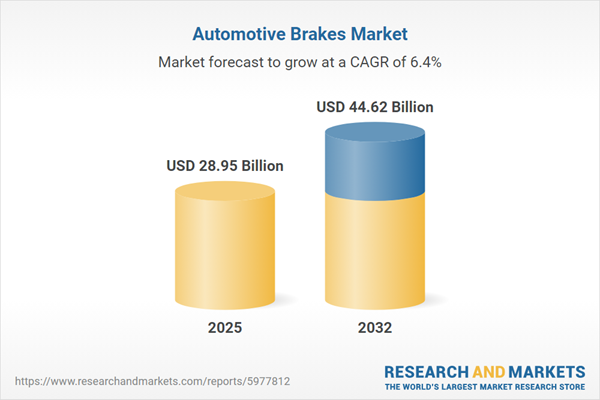Speak directly to the analyst to clarify any post sales queries you may have.
The automotive brakes market is experiencing swift evolution as advanced technologies emerge, regulatory frameworks change, and supply chain structures grow more complex. For senior decision-makers, anticipating these shifts is essential to maintaining a strategic edge in a competitive landscape.
Market Snapshot: Automotive Brakes Market Size and Growth
The global automotive brakes market is valued at USD 27.22 billion in 2024 and is forecast to reach USD 44.62 billion by 2032, at a CAGR of 6.36%. This expansion is primarily driven by increased deployment of electronic braking systems, a response to strengthened safety standards and continuous technical improvements for both commercial and passenger vehicles. Market leaders focusing on compliance, efficiency, and sustainable decision-making must continuously assess these drivers and the evolving competitive environment to develop resilient business strategies.
Scope & Segmentation of the Automotive Brakes Market
- System Components: Calipers, discs, drums, master cylinders, pads, and shoes are essential across various vehicle categories, supporting uptime, streamlined service intervals, and cost-effective operation for large and mixed fleets.
- Brake Types: Evaluating both disc and drum brake configurations ensures compatibility with legacy and new vehicle architectures, a key consideration for organizations upgrading or expanding their fleets.
- Friction Materials: Decisions between ceramic, organic, and semi-metallic friction materials influence wear, sustainability goals, and cost planning, directly affecting both original equipment and aftermarket approaches.
- Distribution Channels: Original equipment manufacturer and aftermarket distribution each require strategic management of inventory and logistics, with adaptability crucial to maintaining supply chain continuity amid global disruptions.
- Vehicle Types: Heavy trucks, light commercial vehicles, and passenger cars (including electric vehicle and conventional models) each need tailored braking solutions aligned to diverse operational requirements and future expansion plans.
- Braking System Technologies: Anti-lock systems, electronic brakeforce distribution, hydraulic braking, and electronic stability control all play roles in tightening compliance and facilitating cross-market standardization.
- Geographical Coverage: Analysis spans the Americas, Europe, Middle East & Africa, and Asia-Pacific, revealing critical distinctions in regulatory environments, sourcing approaches, and opportunities for regional partnerships and energy-efficient technology deployment.
- Company Profiles: Sector innovators, including Robert Bosch GmbH, Continental AG, ZF Friedrichshafen AG, Brembo S.p.A., and Aisin Seiki Co., Ltd., drive advancements and contribute to standard-setting, influencing sector direction through ongoing research and product release cycles.
Key Takeaways: Strategic Insights for Senior Decision-Makers
- Integrating smart and connected braking platforms promotes regulatory alignment and fosters production quality and in-vehicle reliability across operations.
- Adopting sustainable friction materials helps organizations address environmental mandates and meet evolving expectations from regulators and stakeholders about responsible sourcing and product stewardship.
- Investing in next-generation solutions, such as brake-by-wire, opens channels for collaborating with specialized technology firms, supporting swift integration as electric and hybrid vehicle markets expand.
- Expanding offerings with aftermarket solutions, including remanufactured components and digital customer support, boosts product lifespan, customer loyalty, and brand reputation in demanding channels.
- Diversifying procurement and supplier strategies allows organizations to effectively address shifting international trade policies and strengthen resilience throughout changing supply chain environments.
Tariff Impact: U.S. Regulatory Changes and Supply Chain Response
Recent adjustments in U.S. tariffs on brake-related components are prompting many manufacturers to reconfigure their supply chains. Industry executives are increasing investments in domestic production and developing stronger supplier partnerships. These strategies are designed to lower compliance risk, improve operational continuity, and ensure access to critical market segments in an increasingly regulated climate. Integration of aftermarket-focused support programs and efforts to vertically align supply structures also support risk mitigation and adaptability.
Methodology & Data Sources
This research draws from interviews with senior industry executives, procurement specialists, and experts in automotive braking systems. Findings have been triangulated with trade publications, regulatory releases, and customs documentation, ensuring robust validity and precision tailored to executive interests.
Why This Report Matters
- Equips executive teams with the knowledge required to align strategies with evolving safety regulations and integrated technology trends in the automotive brakes market.
- Supports agile operations, enabling rapid response to market changes and the protection of innovation capacity within organizations.
- Helps procurement and supply chain leaders anticipate market shifts, manage risk proactively, and secure strong competitive positions in a complex global landscape.
Conclusion
These insights equip senior leaders to refine long-term growth plans, strengthen their strategic positioning, and enhance organizational adaptability as market trends and challenges continue to emerge.
Additional Product Information:
- Purchase of this report includes 1 year online access with quarterly updates.
- This report can be updated on request. Please contact our Customer Experience team using the Ask a Question widget on our website.
Table of Contents
3. Executive Summary
4. Market Overview
7. Cumulative Impact of Artificial Intelligence 2025
Companies Mentioned
The companies profiled in this Automotive Brakes market report include:- Robert Bosch GmbH
- Continental AG
- ZF Friedrichshafen AG
- Brembo S.p.A.
- Aisin Seiki Co., Ltd.
- Mando Corporation
- Akebono Brake Industry Co., Ltd.
- Hitachi Astemo, Ltd.
- Nissin Kogyo Co., Ltd.
- Tenneco Inc.
Table Information
| Report Attribute | Details |
|---|---|
| No. of Pages | 192 |
| Published | October 2025 |
| Forecast Period | 2025 - 2032 |
| Estimated Market Value ( USD | $ 28.95 Billion |
| Forecasted Market Value ( USD | $ 44.62 Billion |
| Compound Annual Growth Rate | 6.3% |
| Regions Covered | Global |
| No. of Companies Mentioned | 11 |









